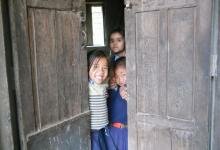Nothing to Sacrifice
Cheerless Eid for Sindh flood survivors in Pakistan.
 Flood survivors across Pakistan’s Sindh province say they have received very little help, even as disease begins to spread, and people who have lost crops, livestock and homes wonder how they are to survive.
Flood survivors across Pakistan’s Sindh province say they have received very little help, even as disease begins to spread, and people who have lost crops, livestock and homes wonder how they are to survive.
For most, even the recent festival of Eid-ul-Adha, which marks the end of the Hajj pilgrimage to Mecca in Saudi Arabia and is usually celebrated by sacrificing an animal such as a goat and engaging in family celebrations that include sharing gifts and meals, was a joyless affair.
“My mother-in-law, who is in her 70s, has high fever and tremors. But we can’t afford to get her to a doctor or buy any medicine,” said Sumbul Bibi, who is also concerned her three small children are not getting enough food.
“No supplies have been delivered to our area for weeks, and we lost our animals and crops in the flood, so we have barely anything to eat beyond some dried dates and a little rice donated by a neighbour,” she said from her village in Sanghar, one of the worst-hit districts in the southern Sindh province.
They had been “very eager to celebrate Eid” as she and her husband feared it could be his mother’s last, but “we could only put together a small, very skimpy meal to eat together”.
Even in the town of Sanghar itself, about 230km northeast of Karachi, some pools of stagnant water still stand – a reminder of the virtual submersion of the city until last month. “We can see mosquitoes hovering above these ditches where water stands, and malaria is spreading here quite fast,” said Nawaz Ahmed, 40.
Organizations monitoring the situation are just as concerned. In a press release issued after a fact-finding mission to Sanghar and the neighbouring district of Nawabshah, the autonomous Human Rights Commission of Pakistan (HRCP) noted “a plethora of problems facing the rain-affected populations of the two districts. The rains have devastated houses and livelihoods, destroying crops and killing livestock on a large scale. Children and old people are in particularly bad shape and vulnerable to disease.”
HRCP expressed grave concern about the vulnerability of people without adequate shelter, especially children and the elderly. It said people were having difficulties at banks accessing funds donated by the government. “Many people have been unable to access relief, and we have made a complaint about this to provincial authorities,” said an administrative official in Sanghar, who asked not to be named.
Asghar Leghari, a member of a Sindh-based civil society organization, the Peoples’ Accountability Commission on Floods (PACF), explained that, “Things are really bad for flood-affected people across Sindh who have received very little support from the government, and are surviving in a miserable situation.”
Stuck in camps
Organizations such as the Pakistan Red Crescent Society continue to work in Sindh and in a situation report dated 3 November, it said: “288,031 people still remain in more than 900 camps out of which almost 62,141 people are being hosted by families. According to the local authorities, the number of relief camps has reduced as some 113,701 affected people left camps located in Benazirabad, Hyderabad and Dadu districts.”
This has been a cheerless Eid for people who have nothing to celebrate.
Aid workers on the ground say the situation looks bleak. “This has been a cheerless Eid for people who have nothing to celebrate,” said Azhar Ali, who works with the Edhi Foundation charity in Sanghar. He said that for Eid, “some meat has been distributed to flood-affected people, but for some it is hard even to cook it given the conditions they live in”.
In a November overview, the UN Children’s Fund (UNICEF) expressed concern over the plight of people who return home to “dismal conditions”, while the Sindh Provincial Disaster Management Authority stated that as of 5 November, there were 9,178,811 flood-affected people across Sindh, 1,237,432 of them in Sanghar. An estimated 213,928 houses are reported to have been destroyed while 127,444 people remain in relief camps in the district.
“We cannot even think of Eid here, and are hardly aware it has passed,” said Ghulam Hussain, living with his family of six at a relief camp near Sanghar with makeshift tents perched on squelchy earth and no sanitation. “Even the children have not spoken of it, as they usually do when we prepare to buy them new clothes and shoes.”
This article was first published in IRIN.

















